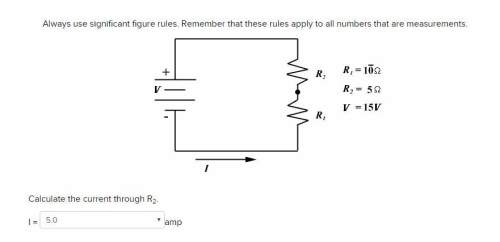

Answers: 1


Another question on Physics

Physics, 21.06.2019 23:00
Athermometer is removed from a room where the temperature is 70° f and is taken outside, where the air temperature is 10° f. after one-half minute the thermometer reads 60° f. what is the reading of the thermometer at t = 1 min? (round your answer to two decimal places.) ° f how long will it take for the thermometer to reach 30° f? (round your answer to two decimal places.)
Answers: 3

Physics, 22.06.2019 00:30
Part f - example: finding two forces (part i) two dimensional dynamics often involves solving for two unknown quantities in two separate equations describing the total force. the block in (figure 1) has a mass m=10kg and is being pulled by a force f on a table with coefficient of static friction îľs=0.3. four forces act on it: the applied force f (directed î¸=30â above the horizontal). the force of gravity fg=mg (directly down, where g=9.8m/s2). the normal force n (directly up). the force of static friction fs (directly left, opposing any potential motion). if we want to find the size of the force necessary to just barely overcome static friction (in which case fs=îľsn), we use the condition that the sum of the forces in both directions must be 0. using some basic trigonometry, we can write this condition out for the forces in both the horizontal and vertical directions, respectively, as: fcosî¸â’îľsn=0 fsinî¸+nâ’mg=0 in order to find the magnitude of force f, we have to solve a system of two equations with both f and the normal force n unknown. use the methods we have learned to find an expression for f in terms of m, g, î¸, and îľs (no n).
Answers: 2

Physics, 22.06.2019 22:00
Aparticle of mass m is placed in a one-dimensional box of length l. the box is so small that the particle’s motion is relativistic, so that e p2/2m is not valid. (a) derive an expression for the energy levels of the particle using the relativistic energy–momentum relation and the quantization of momentum that derives from connement. (b) if the particle is an electron in a box of length l 1.00 1012 m, nd its lowest possible kinetic energy. by what percent is the nonrelativistic formula for the energy in error?
Answers: 1

Physics, 23.06.2019 13:20
Paul and ivan are riding a tandem bike together. they’re moving at a speed of 5 meters/second. paul and ivan each have a mass of 50 kilograms. what can paul do to increase the bike’s kinetic energy?
Answers: 2
You know the right answer?
Calculate the current through r2.
calculate the current through r1.
calculat...
calculate the current through r1.
calculat...
Questions


History, 10.02.2021 08:30



Mathematics, 10.02.2021 08:30

Mathematics, 10.02.2021 08:30




English, 10.02.2021 08:30


Mathematics, 10.02.2021 08:30








Physics, 10.02.2021 08:30





